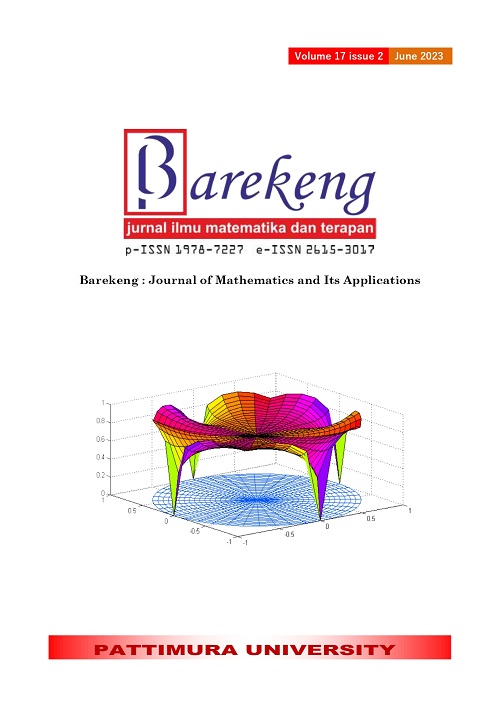IMPLEMENTATION OF FUZZY TIME SERIES CHEN FOR FORECASTING INDONESIAN OIL AND GAS IMPORTS VALUE
Abstract
Indonesia is an importing country that frequently imports goods from abroad continuously every year. Imported goods are oil and gas and non-oil and gas. Oil and gas includes oil and gas. This oil and gas import value data is an example of time series data, where the data is obtained from data recapitulation at the Central Bureau of Statistics (BPS). Time series analysis is a method for predicting an event that will come by looking at data from the previous time. One of the newest methods of time series analysis used in this research is Fuzzy Time Series Chen method. The purpose of this research is to find out how the implementation of Fuzzy Time Series Chen method in predicting the value of Indonesian oil and gas imports and to know the results of forecasting the value of Indonesian oil and gas imports. In predicting the value of Indonesia's oil and gas imports using Fuzzy Time Series Chen method, the results of forecasting the value of Indonesia's oil and gas imports in August 2022 were US$ 3743.213 million with a MAPE value of 19.969%.
Downloads
References
Simarmata and Chanro, “Proyeksi Jumlah Impor Migas dan Non Migas Indonesia Tahun 2010 Berdasarkan Data Impor Tahun 2000 sampai dengan 2007,” Repository of North Sumatra University, North Sumatra University, 2009.
L. Julita, “RI masih Kecanduan Impor Migas? Ini Buktinya,” cnbc Indonesia, 2020. [Online]. Available: www.cnbcindonesia.com/news/20201116132859-4-202114/ri-masih-kecanduan-impor-migas-ini-buktinya. [Accessed 1 Agustus 2022].
B. P. Statistik, “Nilai Impor Migas-Nonmigas,” BPS, 2022. [Online]. Available: www.bps.go.id/indicator/8/1754/1/nilai-impor-migas-nonmigas.html. [Accessed 26 September 2022].
Q.Song and B. S. Chissom, "Forecasting Enrollments with Fuzzy Time Series-Part 1," Fuzzy Sets and Systems, vol. 54, no. 1, pp. 1-9, 1993.
M. K. Vivianti, Aidid and M. Nusrang, “Implementasi Fuzzy Time Series untuk Peramalan Jumlah Pengunjung di Benteng Fort Rotterdam,” VARIANSI: Journal of Statistics and Its Application on Teaching and Research, vol. 2, no. 1, pp. 1-12, 2020.
F. Rachim, T. Tarno and S. Sugito, “Perbandingan Fuzzy Time Series dengan Metode Chen dan Metode S. R. Singh (Studi Kasus: Nilai Impor di Jawa Tengah Periode Januari 2014 – Desember 2019),” J. Gaussian , vol. 9, no. 3, pp. 306-315, 2020.
N. Usmia and Noeryanti, “Peramalan Data Produk Domestik Regional Bruto Daerah Istimewa Yogyakarta Menggunakan Kombinasi Fuzzy Time Series dengan Particle Swarm Optimization,” Jurnal Statistika Industri dan Komputasi, vol. 6, no. 2, pp. 123-131, 2021.
L. A. Zadeh, “Fuzzy Set,” Information and Control, vol. 8, pp. 338-353, 1965.
J. S. R. Jang, C. T. Sun and E. Mizutani, “A Computational Approach to Learning and Machine Intelligence,” in Neuro-Fuzzy and Soft Computing, Upper Saddle River, NJ, Prentice-Hall, 1997.
I. P. Sutikno, “Perbandingan Metode Deffuzifikasi Sistem Kendali Logika Fuzzy Model Madani,” Jurnal Masyarakat Informatika, vol. 2, no. 3, pp. 27-38, 2012.
M. L. Tauryawati and M. I. Irawan, “Perbandingan Metode Fuzzy Time Series Cheng dan Metode Box-Jenkins untuk Memprediksi IHSG,” J. Sains dan Seni ITS, vol. 3, no. 2, pp. 34-39, 2014.
S. M. Chen, “Forecasting Enrollments Based on Fuzzy Time Series,” Fuzzy Sets Syst, vol. 81, pp. 311-319, 1996.
S. Kristien, Margi and W. S. Pandawa, “Analisa dan Penerapan Metode Single Exponential Smoothing untuk Prediksi Penjualan pada Periode Tertentu,” Prosiding SNATIF, vol. 2, pp. 259-266, 2015.
N. Fauziah, S. Wahyuningsih and Y. N. Nasution, “Peramalan Fuzzy Time Series Chen (Studi Kasus: Curah Hujan Kota Samarinda),” Statistika, vol. 4, no. 2, pp. 52-61, 2016.
R. Gao and O. Duru, “Parsimonious Fuzzy Time Series Modelling,” Expert Syst. Appl., vol. 156, p. 113447, 2020.
F. Aditya, D. Devianto and M. Maiyastri, “Peramalan Harga Emas Indonesia Menggunakan Metode Fuzzy Time Series Klasik,” J. Mat. UNAND, vol. 8, no. 2, p. 45, 2019.
Copyright (c) 2023 Septri Damayanti, Siska Yosmar, Nur Afandi

This work is licensed under a Creative Commons Attribution-ShareAlike 4.0 International License.
Authors who publish with this Journal agree to the following terms:
- Author retain copyright and grant the journal right of first publication with the work simultaneously licensed under a creative commons attribution license that allow others to share the work within an acknowledgement of the work’s authorship and initial publication of this journal.
- Authors are able to enter into separate, additional contractual arrangement for the non-exclusive distribution of the journal’s published version of the work (e.g. acknowledgement of its initial publication in this journal).
- Authors are permitted and encouraged to post their work online (e.g. in institutional repositories or on their websites) prior to and during the submission process, as it can lead to productive exchanges, as well as earlier and greater citation of published works.






1.gif)



